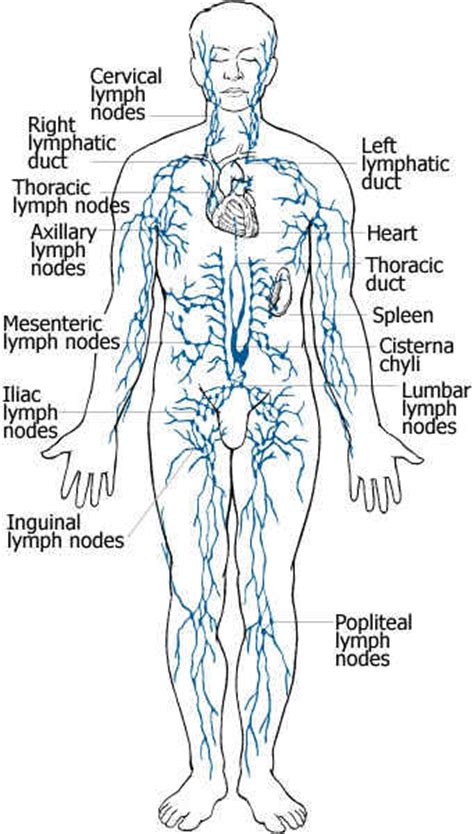



The lymphatic system is part of the circulatory system of the body. It works together with the blood circulation and consists of lymph vessels and lymph nodes and moves a watery fluid called lymph. It starts as very thin delicate vessels in the upper layers of the connective tissues of the body. These vessels gradually become larger in diameter (lymph capillaries) and are intercepted by lymph node groups. Lymph capillaries have valves to keep the lymph flowing in one direction. Lymph capillaries also have muscular units called lymphangions which contract and move the lymph fluid from one segment of the lymph capillary to the next segment.
Lymph nodes can be found in many places in the body. Commonly they are found in the neck, underarms, the trunk of the body and the groin. Smaller nodes may be found behind the knees and ankles. Lymph nodes draw lymph fluid towards them and filter it. Ultimately, this fluid is transported into the neck. This is where the lymphatic and blood vessels meet. See picture below.
The lymphatic system is very important to the body. It absorbs excess fluid, foreign substances and waste products from the tissues, and cleans it, and then returns these substances back to the blood circulation. It is the key system that is responsible for the maintenance of connective tissues. It also regulates fluid volume in the tissues and is important in removing any swelling or edema.
It also stimulates the production of lymphocytes (white blood cells) and is important in the maintenance of the immune system. The lymphatic system is involved in fat digestion. It carries fat absorbed during digestion in the intestinal tract.
As you can see, this is an important system and worthwhile learning a bit more about!

The primary way lymph moves in the body is through lymphangions. These are muscular units located inside larger lymph vessels also known as lymph capillaries. These units pump the lymph fluid from one segment of the vessel to the next segment, much like the peristaltic action found in the bowels.
Of course there are other ways lymph can be stimulated:
Sometimes the body has difficulty moving the lymph in an efficient manner. This happens when the lymphatic system may be overloaded with too much fluid in the tissues resulting in a condition called edema.
When a patient experiences edema or swelling in the tissues, Manual Lymph Drainage may be helpful.
Lymphatic drainage massage is a gentle form of massage done directly on dry skin with very little pressure. It has a deeply relaxing effect on the body, promotes circulation and lymph drainage in the connective tissues which improves tissue health. It is effective in reducing excess fluids such as edema from the connective tissues.
Manual Lymphatic Drainage therapy is not covered by OHIP. In many cases, it may be covered under extended health insurance under ‘Registered Massage Therapy’. However, it is wise to check with your insurance provider before considering booking an appointment for MLD massage.